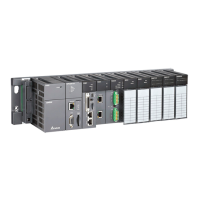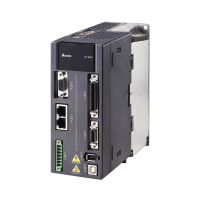AH500 Programming Manual
6-184
Function
Setting range Description Device number
to 0 when the
independent
formula is used,
the proportional
Ti_Ki
REAL
Integral gain (Ti or Ki)
(The selection of Ti or
Ki depends on the
setting of the
parameter PID_EQ.)
Range of
positive single
precision
floating-point
values (Unit:
Ti=Second;
Ki=1/second)
gain. If an integral
gain is less than 0,
Ti_Ki will be count
as 0. If Ti_Ki is
equal to 0, the
integral control is
Td_Kd
REAL
Derivative gain (Td or
Kd) (The selection of
Td or Kd depends on
the setting of the
parameter PID_EQ.)
Range of
positive single
precision
floating-point
values (Unit:
Second)
gain. If a derivative
gain is less than 0,
Td_Kd will be
count as 0. If
Td_Kd is equal to
0, the derivative
Tf
REAL
Derivative action time
constant (Tf)
Range of
positive single
precision
floating-point
values (Unit:
Second)
action time
constant. If the
derivative action
time constant is
less than 0, Tf will
be count as 0. If Tf
is equal to 0, the
derivative action
time control is not
used. (Derivative
PID_EQ
BOOL
Selection of a PID
formula
TRUE:Dependent Formula
FALSE:Independent Formula
PID_DE
BOOL
Selection of the
calculation of the PID
derivative error
True: Using the variations in the PV to
calculate the control value of the
derivative (Derivative of the PV)
False: Using the variations in the
error (E) to calculate the control
value of the derivative (Derivative
PID_DIR
BOOL
direction
True: Reverse action (E=SV-PV)
False: Forward action (E=PV-SV)
ERR_DBW
REAL
Range within which
the error value is
counted as 0
Range of
single-precision
floating-point
numbers
equal to SV− PV or
PV-SV. If the
setting value is 0,
the function will not
be enabled,
otherwise the CPU
module will check
whether the

